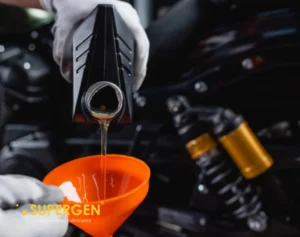Introduction:
Choosing the right engine oil is a critical aspect of maintaining the health and performance of your vehicle, especially in the diverse and challenging driving conditions of India. One of the key factors to consider when selecting engine oil is its viscosity grade. Viscosity refers to the oil’s resistance to flow, and the right viscosity grade ensures proper lubrication and protection for your engine. In this blog, we will delve into the importance of viscosity grades and guide you in selecting the ideal engine oil for Indian driving conditions.
What is Viscosity?
Viscosity is a measure of how thick or thin an oil is. It determines how effectively the oil can flow and lubricate engine components. Engine oils have two numbers to indicate viscosity, such as 10W-40. The “W” stands for winter, and the number before it represents the oil’s viscosity at low temperatures. The number after the “W” represents the oil’s viscosity at higher temperatures.
The Role of Viscosity Grades:
In India, where temperatures can vary greatly from hot summers to colder winters, selecting the right viscosity grade is crucial. During cold starts, you need an oil that flows easily to protect engine parts. Conversely, at higher temperatures, the oil should maintain adequate thickness to provide sufficient lubrication.
Understanding Multi-Grade Oils:
Multi-grade oils, like 10W-40, are designed to perform well in both cold and hot temperatures. The first number (10W) indicates the oil’s flowability in cold weather, while the second number (40) indicates its viscosity at higher temperatures. Multi-grade oils are ideal for Indian driving conditions, as they offer versatility in varying climates.
Selecting Viscosity Grades for Indian Climate Zones:
- Hot and Humid Climates: In regions with high temperatures and humidity, such as coastal areas, consider multi-grade oils with lower first numbers (e.g., 5W or 10W) for better cold start protection and higher second numbers (e.g., 40 or 50) for adequate high-temperature lubrication.
- Cold and Hilly Regions: For colder regions, especially in the hilly areas, opt for multi-grade oils with lower first numbers (e.g., 0W or 5W) to ensure smooth cold starts, and moderate second numbers (e.g., 30 or 40) to maintain viscosity at higher temperatures.
Consider Your Vehicle’s Age and Usage:
The age and usage of your vehicle also play a role in selecting the right viscosity grade. Older engines or those with higher mileage might benefit from slightly thicker oils (higher second numbers) to compensate for potential wear and tear. Newer engines generally perform well with recommended multi-grade oils.
Consult Your Vehicle Manual:
Always refer to your vehicle’s manual for the manufacturer’s recommended viscosity grades. The vehicle manufacturer knows the engine’s specific requirements best and provides guidelines to ensure optimal performance and longevity.
Conclusion:
Selecting the ideal engine oil viscosity grade is crucial in ensuring proper engine lubrication and protection, especially in the diverse driving conditions of India. Multi-grade oils are generally the best choice, as they provide versatile performance in both cold and hot temperatures. Consider your vehicle’s age, usage, and the climate zone you operate in to make the most suitable choice. Regularly change your engine oil as per the manufacturer’s recommendations to keep your vehicle running smoothly and efficiently throughout its life, providing you with a reliable and enjoyable driving experience on India’s roads.










